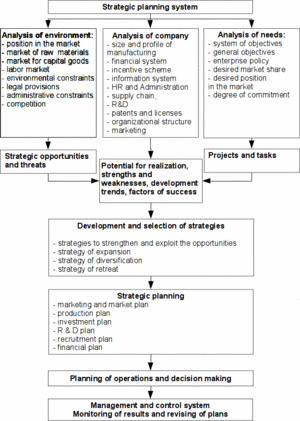Strategic planning
| Strategic planning |
|---|
| See also |
Strategic planning is a formal strategic planning process focused on the long-term activities specifying and implementing the objectives of the organization. Is characterized by the following features:
- Applies to basic issues. Strategic planning provides answers to such questions as: "what do we do and what we should concern ourselves with", "who are we, and who should be our customers?".
- Provides a framework for the planning of the tactical and operational activities, and everyday decisions. In view of the need to make decisions manager ask: "which of the possible lines of action will best match our strategy?"
- It is associated with a longer time horizon than other types of planning.
- Makes it easier to focus energy and resources on the most important activities.
- It is activity of head managers of organization, which must have sufficient knowledge and experience, in order to take into account all aspects of the functioning of the organization. Commitment of head managers is also necessary in order to induce and sustain engagement at lower levels of organization.
The strategic planning Process
The strategic planning process is first in a sequence of management activities whose goal is to introduce and implement the best strategy for the company. Diagram of this process is shown in the figure below.
Fig. 1. puts the elements of strategic analysis (analysis of the company and the environment) as part of the planning system. Separation of the strategic analysis subsystem from the planning subsystem is desired. Strategic analysis is the basis for planning but is used also for other activities of the management, such as: monitoring, implementation of strategy, analysis of the company situation, etc.
The starting point in determining strategic plans is to develop enterprise mission and vision. Vision is a compact script, image of the future company, which should contain the following elements:.
- description of the perceived environment of business, in particular the social change leading to the reproach of old and generation of new ideas,
- domain definition for detailing potential areas of the market in which the company intends to operate,
- a description of the characteristic (permanently outstanding) competences in the company now or in the future,
- understanding the likely route from the place now occupied by the company to the place which it is hoping to take by constantly creating its distinctive competence.
Planning and decision-making
Strategic planning steps remains in close connection with the decision making process. This connection occurs already at the stage of formulation of the objectives of the company (in the case of strategic management: its mission and vision), then the acceptance of variants of different strategies (programs) and, finally, in monitoring of their implementation. Interactions between these features are very strong, but in the financial planning only preparation activities prevail, while the decision making applies to the allocation of financial resources between the different business units, determining the key products and scale of production, defining the field of diversification, the development of pricing strategy.
Strategic planning role
Strategic planning should be an integral part of the management of the enterprise and, therefore, must take into account the limitations imposed by considerations such as: conflicting interests, financial barriers, resource constraints, lack of information, strategic potential, lack of competence, the expected change in an environment, competition, etc.
See also:
References
- Mintzberg, H. (1994). The fall and rise of strategic planning. Harvard business review, 72(1), 107-114.
Author: Krzysztof Wozniak
